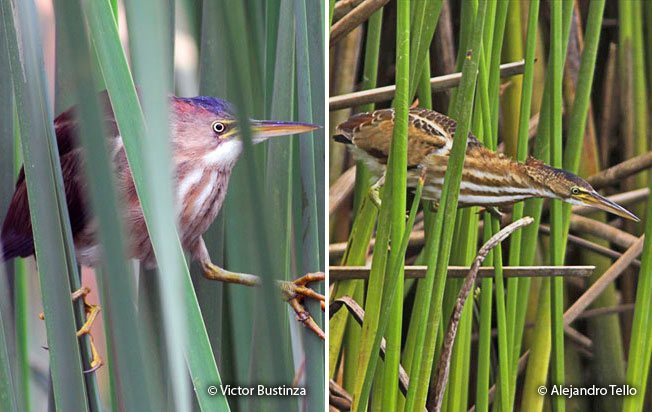Order: Pelecaniformes | Family: Ardeidae | IUCN Status: Least Concern

Age: Adult | Sex: Male | Loc. Florida, USA

Age: Adult | Sex: Female | Loc. Florida, USA

Age: Adult | Sex: Male | Loc. Camana, Peru

Age: Adult (L) and Juvenile (R) | Sex: Unknown | Loc. Lima, Peru
Identification & Behavior: ~30 cm (12 in). The male Least Bittern has a black cap and a black back with the rest of the body in shades of rufous and brown. It has conspicuous pale streaks running down the front of the neck. It is secretive and forages by perching on vertical reeds or cattail over the water. Females are a dull version of males. Similar to Stripe-backed Bittern and Striated Heron. But the solid black back and rufous-brown body should be diagnostic. Juveniles lack the black cap and back.
Status: The Least Bittern is generally uncommon in coastal wetlands and more localized in the Amazonian lowlands. It also occurs in Co, Ec, Br, and Bo.
Name in Spanish: Mirasol Leonado.
Sub-species: Least Bittern (Ixobrychus exilis peruvianus) Bond, 1955. West-central Peru.
(I. e. limoncochae) Norton, DW, 1965. Amazonia?
Meaning of Name: Ixobrychus: Gr. Ixias= stick, reed, and brychus, brukhomai= down (bottom of a stick). exilis: L. small, slender.
Distribution Map
 Voice
Voice
 Voice
VoiceReferences:
-
- Species range based on: Schulenberg, T. S., D. F. Stotz, and L. Rico. 2006. Distribution maps of the birds of Peru, version 1.0. Environment, Culture & Conservation (ECCo). The Field Museum. http://fm2.fieldmuseum.org/uw_test/birdsofperu on 01/01/2015.